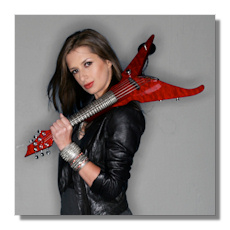
The Internet's Premier Classical Music Source
Related Links
- Latest Reviews
- More Reviews
-
By Composer
-
Collections
DVD & Blu-ray
Books
Concert Reviews
Articles/Interviews
Software
Audio
Search Amazon
Recommended Links
Site News
 Concert Review
Concert Review
Milosavljevic Premieres

- Ana Milosavljevic:
- Reflections for Violin & Orchestra
- Red for Orchestra (2013)
- Viper Concerto for Viper Electric Violin & Orchestra
- Piotr Ilyitch Tchaikovsky: Symphony #1 "Winter Daydreams"
Ana Milosavljevic, violin & Viper electric violin
Sheboygan Symphony Orchestra/Kevin R. McMahon
Stephanie H. Weill Center for the Performing Arts, Sheboygan, Wisconsin, 7 February 2015
Ana Milosavljevic, born in Serbia, where she attended the School for Musically Gifted Children and earned her bachelor's degree, lives as a permanent U.S. resident in New York. She teaches in the Preparatory Division of Mannes College of the New School, where she earned a master's degree and professional studies diploma. She also teaches at the Brearley School. Among her distinctions are a MacDowell Colony Fellowship, as well as grants and awards from the Alice M. Ditson Fund of Columbia University, the Soros Fund, and the Lower Manhattan Cultural Council. Her music has been broadcast by the BBC, the Voice of America, and by WQXR and WNYC. She has also collaborated with the Silk Road percussionist Shane Shanahan, and with John King, former Co-Director of the Merce Cunningham Dance Company. Venues for her solo recitals include Carnegie Hall, Lincoln Center, Kennedy Center, and she has appeared at major festivals from Jacob's Pillow to Beijing. "Reflections," in its original version for violin and piano, was recorded on Innova; as a performer, Milosavljevic has recordings on Albany.
The world premiere "Reflections" in a version for full orchestra is a short piece which Milosavljevic played on a traditional acoustic violin. The title refers to mental reflections, not mirror images, and she says the piece had its origins in reflections about her personal life, family and friends. Expressing feelings of both sadness and hope, it begins and ends softly. Its pace is steady; the woodwinds, especially English Horn, have a rhapsodic passage. The orchestral part is for full orchestra, which is given full voice, and is quite engaging.
"Red" was originally for string quartet and optional additional instrument. It was premiered by the string quartet Ethel, with flutist Robert Mirabel, in 2011 at the Akron (Ohio) Art Museum. A subsequent version for string orchestra was played in Serbia and was used in a ballet choreographed by Takehiro Ueyama for Juilliard's New Dances. The orchestral version was commissioned by the South Shore Orchestra and premiered in Valparaiso, Indiana. It is for full orchestra and includes a harp solo. For the composer the color red has a number of associations with positive and life-affirming qualities. Like "Reflections," it is short and again has a quiet beginning and ending, but with a "blazing climax," in the apt words of the program annotator, Joseph Milicia, one of the clarinet players.
The world premiere of the "Viper Concerto" (commissioned by the Sheboygan Symphony Orchestra) is for large orchestra including strings, full woodwind and brass sections, harp, and a large percussion section: timpani, snare drum, bass drum, cymbals, gong, tambourine, tubular bells, glockenspiel, and of course the solo Viper electric violin. This Viper, a hand-crafted instrument of an unusual shape, and which is strapped to the performer, allowing free movement on stage, has six strings, which extend its range down to the bass clef. It has frets. Its sound, generally mellow, can be manipulated by foot pedals for unusual effects, and for volume capacity so as never to be overwhelmed by the orchestra.
The style of Milosavljevic's music heard on this occasion is somewhat eclectic – much more so than in some works of hers performed elsewhere, as I understand. It is tonal, seemingly modal rather than diatonic, and melodic. Her rhythms are pronounced, with frequent change of time signature, which the performers were able to handle with ease. The percussion in the concerto is very prominent – in the other works also; the timpanist, particularly, had a lot to do, with a part which must have been especially satisfying to play. The short works displayed a dynamic arc in both cases; the concerto, in a single movement, built to a tremendous conclusion which was positively glorious and the audience responded accordingly with a big ovation.
The Winter Daydreams performance was pleasurable, with satisfying tempos and some gorgeous oboe and flute solos. The slow movement was especially good. There were a few balance and intonation concerns in the Tchaikovsky, but the orchestra's clear articulation and ability to deal with the numerous rhythmic and metric changes in the Milosavljevic concerto were outstandingly good and do both McMahon and the players in general proud. I have noticed that these players always put themselves out to provide strong accompaniment for visiting soloists.
Copyright © 2015, R. James Tobin












